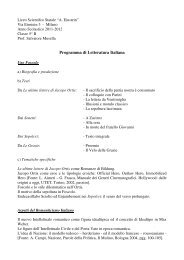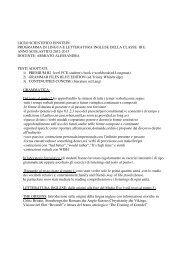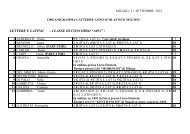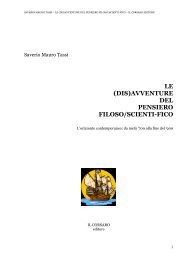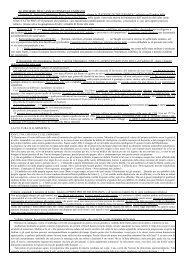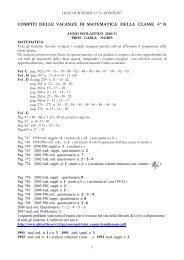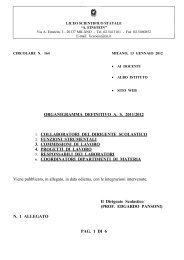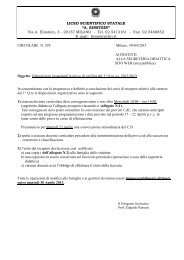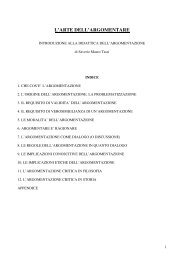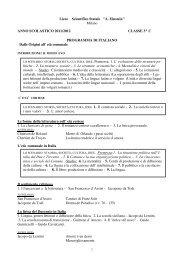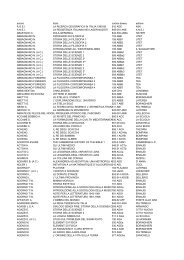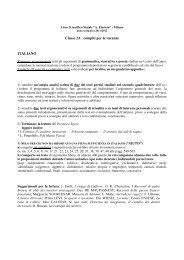Presentazione di PowerPoint - Liceo scientifico Albert Einstein
Presentazione di PowerPoint - Liceo scientifico Albert Einstein
Presentazione di PowerPoint - Liceo scientifico Albert Einstein
Create successful ePaper yourself
Turn your PDF publications into a flip-book with our unique Google optimized e-Paper software.
Approfon<strong>di</strong>menti <strong>di</strong> cosmologia<br />
C'è ma non si vede: la materia oscura<br />
Aniello Mennella<br />
Dipartimento <strong>di</strong> Fisica<br />
Università degli Stu<strong>di</strong> <strong>di</strong> Milano<br />
<strong>Liceo</strong> <strong>scientifico</strong> A. <strong>Einstein</strong>, 1 febbraio 2008
Le galassie<br />
●<br />
Le galassie, ammassi <strong>di</strong> miliar<strong>di</strong> <strong>di</strong> stelle legate<br />
gravitazionalmente<br />
●<br />
La loro natura scoperta da Edwin Hubble che ne<br />
effettuò una catalogazione morfologica<br />
●<br />
Nei primi anni '70 lo stu<strong>di</strong>o delle galassie a spirale<br />
fornisce l'evidenza della presenza <strong>di</strong> materia<br />
oscura
M101
NGC4036
NGC1300
ESO 325-G004 in Abell S740
Come gira una galassia a spirale?
In un corpo rigido in<br />
rotazione la velocità<br />
aumenta linearmente<br />
con la <strong>di</strong>stanza<br />
velocità<br />
<strong>di</strong>stanza
In un sistema<br />
planetario la velocità<br />
decresce come 1/r 1/2
In un sistema<br />
planetario la velocità<br />
decresce come 1/r 1/2
In una galassia la velocità<br />
ha un andamento misto:<br />
come un corpo rigido vicino<br />
al centro e come un sistema<br />
planetario al bordo
.... e le misure?
Rotation curves of 967<br />
spiral galaxies<br />
Massimo Persic – Paolo Salucci<br />
The Astrophysical Journal Supplement<br />
Series<br />
Agosto 1995
La struttura della materia nell'universo<br />
Millennium simulation: simulating the joint evolution of quasars,<br />
galaxies and their large-scale <strong>di</strong>stribution<br />
(Volker et al, Nature, 2005)
L'evoluzione della materia<br />
nell'universo
t = 0.21 miliar<strong>di</strong> <strong>di</strong> anni
t = 1 miliardo <strong>di</strong> anni
t = 4.7 miliar<strong>di</strong> <strong>di</strong> anni
t = 13.6 miliar<strong>di</strong> <strong>di</strong> anni
t = 0.21 miliar<strong>di</strong> <strong>di</strong> anni
t = 1 miliardo <strong>di</strong> anni
t = 4.7 miliar<strong>di</strong> <strong>di</strong> anni
t = 13.6 miliar<strong>di</strong> <strong>di</strong> anni





